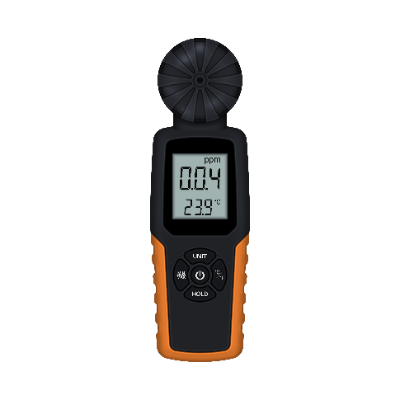What Is an Ozone Concentration Meter?
 An ozone concentration meter is a measurement instrument to determine the concentration of ozone in air or liquid.
An ozone concentration meter is a measurement instrument to determine the concentration of ozone in air or liquid.
It is used to control the concentration of ozone in gases and liquids to the appropriate concentration for the intended use, or to prevent accidents caused by ozone generation and its effects on the human body and the environment.
Ozone concentration meter measurement methods include the ultraviolet absorption method, semiconductor thin film method, constant potential electrolysis method, and detector tube method. The introduction cost and maintenance cost vary depending on the measurement method. Selection should take into account the purpose of use, working range, working environment, size, accessories, consumables, etc.
Usage of Ozone Concentration Meters
An ozone concentration meter is used to introduce ozone generating equipment or to control ozone concentration appropriately in an ozone-prone environment. Ozone is a useful compound in various industries, such as sewage and water treatment, medical industry, sterilization and deodorization of food, and storage.
However, at high concentrations, it can have adverse effects on the human body and the environment. For example, the allowable concentration as a working environment standard set by Japan is 0.1 ppm (0.2 mg/m3).
In addition, ozone is generated in the presence of ultraviolet rays and electrical discharges in the air. Therefore, an ozone concentration meter is used not only near ozone generators but also in places where ozone can be generated in the work environment.
Principle of Ozone Concentration Meters
An ozone concentration meter has several methods and different principles. However, most measurement methods utilize the oxidation reaction of ozone.
Note that ozone is highly unstable and tends to decrease in concentration during measurement, as it changes from ozone (03) to oxygen (02).
Types of Ozone Concentration Meters
There are various types of ozone concentration meter depending on the measurement principle. This section describes the ultraviolet absorption method, the semiconductor thin-film method, the constant potential decomposition method, and the detector tube method.
1. Ultraviolet Absorption Method
The ultraviolet absorption method is a measurement method that makes use of the fact that ozone strongly absorbs ultraviolet rays at a wavelength of 254 nm. 254 nm ultraviolet rays are absorbed only by ozone molecules, so the ozone concentration can be measured from the amount of ultraviolet light absorbed.
The UV absorption method can measure ozone concentration in both liquid and vapor phases. One point to note is the presence of other gases in the mixture can affect the measured value. The UV absorption method is suitable for continuous measurement and very convenient for experiments, but it is an expensive method.
2. Semiconductor Thin Film Method
This method utilizes the fact that ozone molecules bind to semiconductors and change the decomposition rate of semiconductors due to the oxidizing power of ozone when ozone comes into contact with the surface of a semiconductor thin film. The semiconductor before decomposition and the decomposition rate are used to measure the ozone concentration. The semiconductor thin-film method is a measurement method with excellent reproducibility and long-term stability.
3. Constant Potential Electrolysis Method
The constant potential electrolysis method is a method of measuring ozone concentration based on the amount of electric current generated when ozone gas is electrolyzed on electrodes maintained at a constant potential. Since the amount of power generated by electrolysis varies depending on the type of gas, the measured value is not easily affected, even when other gases are mixed in.
The constant potential electrolysis method is extremely sensitive, enabling quantitative measurements even in low-concentration areas, and enables high-precision ozone concentration measurements at a relatively low cost.
4. Detector Tube Method
The detector tube method measures the concentration of a sample packed in a glass tube based on the length of discoloration. The glass tube is filled with layers of various samples, such as indigo dye, and the sample is fixed and sealed.
The glass tube is broken at both ends, one end is placed in the gas to be sampled, and the other end is connected to a small manual pump, known as a gas detector, which draws a fixed amount of gas (usually 100cc) through the glass tube at a fixed rate into the pump. As the ozone flows in, the sample changes color, and the ozone concentration can be measured from the length of the change in color. This method is relatively inexpensive, easy to test, and can measure relatively low concentrations.